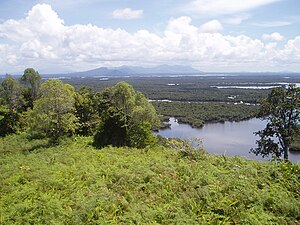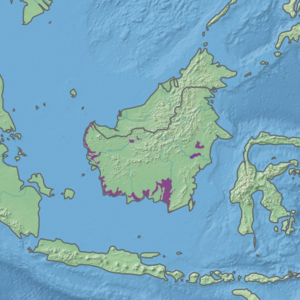Southwest Borneo freshwater swamp forests
| Southwest Borneo freshwater swamp forests | |
|---|---|
 | |
 Ecoregion territory (in purple) | |
| Ecology | |
| Realm | Indomalayan |
| Biome | Tropical and subtropical moist broadleaf forests |
| Geography | |
| Area | 36,849 km2 (14,227 sq mi) |
| Country | Indonesia, Malaysia |
| Coordinates | 1°15′N 111°15′E / 1.25°N 111.25°E |
The Southwest Borneo freshwater swamp forests ecoregion (WWF ID: IM0153) covers a number disconnected patches of freshwater swamp forest along the southwestern coasts of Borneo. The swamps are generally set back a few kilometers or two from the sea by the saltwater-affected Sunda Shelf mangroves The relatively fertile, flat soil has led to much of this ecoregion being converted to agriculture.[1][2][3][4]
Location and description
[edit]The freshwater swamp forests of the southwest coast of Borneo occur where rivers on flat alluvial plains meet the coastal mangroves. The resulting sediment and periodic inundation produce more nutrient-rich, less acidic soil, and taller trees than peat swamps[4]
Climate
[edit]The climate of the ecoregion is Tropical rainforest climate (Köppen climate classification (Af)). This climate is characterized as hot, humid, and having at least 60 mm of precipitation every month.[5][6]
Flora and fauna
[edit]The makeup of these forests varies according to patterns of inundation, soil nutrient levels and acidity.[1] There are grassy wetlands, marshes, areas of scrub, and areas of Pandanus and palm trees. The mature forest supports a wide variety of tree and shrub species, including the families and genera of Adina a shrub, Alstonia (some species of which are of commercial value for timber), Campnosperma, Coccoceras, Dillenia, Dyera, Erythrina, Eugenia, Ficus, Gluta, Lophopetalum, Memecylon, Pentaspadon, Shorea, and Vatica.[4]
Diversity of faunal species is higher than in the peat swamp. The most common primate in the freshwater swamp is the vulnerable Crab-eating macaque (Macaca fascicularis). The freshwater swamp is also home to the critically endangered Bornean orangutan (Pongo pygmaeus). Over 360 species of birds have been recorded in this ecoregion.[4]
Protected areas
[edit]Over 14% of the ecoregion is officially protected.[3] These protected areas include:
References
[edit]- ^ a b "Southwest Borneo freshwater swamp forests". World Wildlife Federation. Retrieved March 21, 2020.
- ^ "Map of Ecoregions 2017". Resolve, using WWF data. Retrieved September 14, 2019.
- ^ a b "Southwest Borneo freshwater swamp forests". Digital Observatory for Protected Areas. Retrieved August 1, 2020.
- ^ a b c d "Southwest Borneo freshwater swamp forests". The Encyclopedia of Earth. Retrieved August 28, 2020.
- ^ Kottek, M.; Grieser, J.; Beck, C.; Rudolf, B.; Rubel, F. (2006). "World Map of Koppen-Geiger Climate Classification Updated" (PDF). Gebrüder Borntraeger 2006. Retrieved September 14, 2019.
- ^ "Dataset - Koppen climate classifications". World Bank. Retrieved September 14, 2019.
